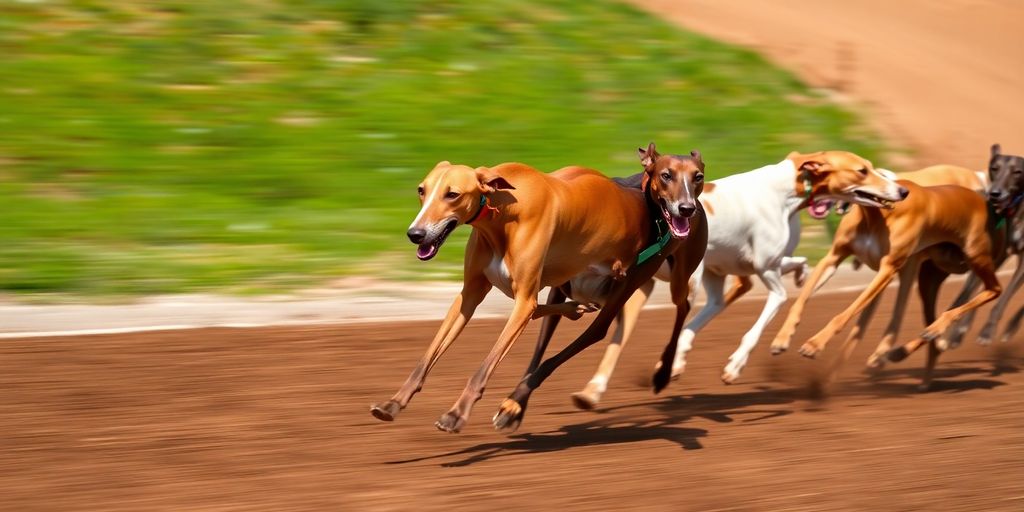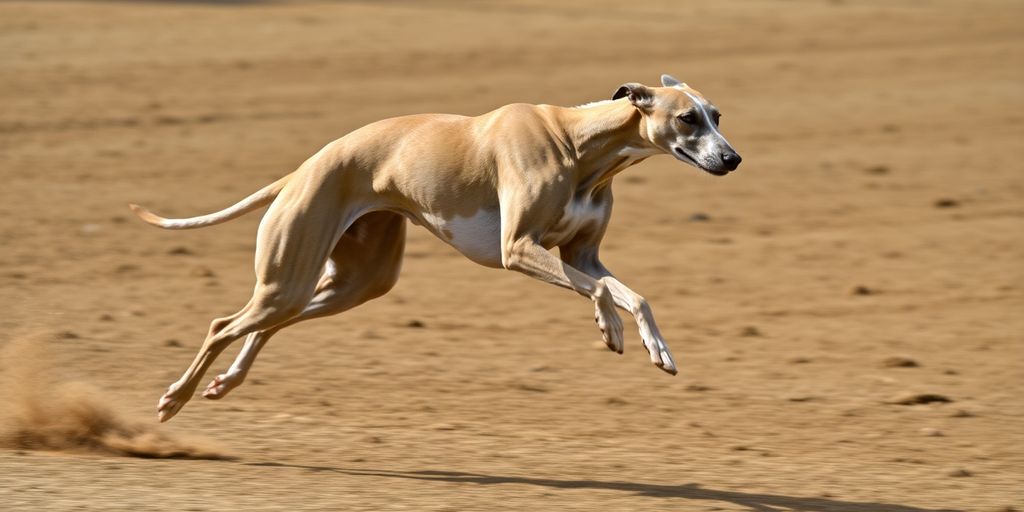Greyhound dog racing has a long, complicated past in Wales, and now its future looks pretty shaky. This sport, once super popular, is facing a possible ban from the Welsh government. It’s a big deal, bringing up all sorts of arguments about animal care, jobs, and what it means to lose a long-standing tradition. We’re going to look at how we got here, what’s happening now, and what might be next for greyhound dog racing.
Key Takeaways
- Greyhound dog racing has deep roots in Wales, going back almost a century, and it used to draw huge crowds.
- The Welsh government wants to ban greyhound dog racing, mainly because of concerns about animal welfare.
- This proposed ban has caused a lot of arguments, with animal groups on one side and the racing industry on the other.
- Stopping greyhound dog racing could mean job losses and changes for local communities.
- What happens in Wales with greyhound dog racing might set an example for other places in the UK, especially since the number of tracks is already going down.
The Historical Roots of Greyhound Dog Racing in Wales
Early Beginnings of Greyhound Dog Racing
So, greyhound racing in Wales? It’s been around for longer than you might think. The first races actually took place way back on April 7, 1928. Can you imagine? That’s almost a century of dogs chasing lures around a track. It’s wild to think about how much things have changed since then. I mean, back then, cars were still pretty new, and now we’re talking about banning greyhound racing. Times really do change.
Peak Popularity and Spectator Engagement
At its height, greyhound racing was HUGE in Wales. We’re talking tens of thousands of people packing into stadiums to watch the races. The Welsh White City Stadium in Cardiff was a major draw, supposedly pulling in crowds of around 25,000. That’s like a small city showing up to watch some dogs run! It’s hard to imagine that kind of excitement around the sport now, especially with everything that’s going on. It really was a different time. The sport was a major social event, bringing communities together.
Evolution of Stadiums and Facilities
Over the years, the stadiums themselves have changed a lot. Take the Valley Greyhound Stadium, for example. It opened in 1976 and has been renovated a bunch of times since then. They even added an indoor lounge and a licensed bar back in 2011. It’s kind of funny to think about people sipping drinks while watching dogs race. The stadium got a license from the Greyhound Board of Great Britain (GBGB) in August 2023, which means it was following all the modern rules for animal welfare and racing standards. It’s a shame that even with all those improvements, the future of the stadium is so uncertain. It’s a big deal for the local area, and it’s sad to see that sports betting might disappear.
It’s interesting to think about how much history is tied up in these old stadiums. They’re not just places where dogs run; they’re places where people have gathered for generations, creating memories and traditions. It’s a shame that all of that could be coming to an end.
The Welsh Government’s Stance on Greyhound Dog Racing
Official Announcement of Proposed Ban
On February 18, 2025, Deputy First Minister Huw Irranca-Davies made it official: the Welsh government plans to ban greyhound racing "as soon as practically possible." Wales is aiming to be the first UK nation to outlaw the sport. This announcement signals a major shift in the country’s approach to greyhound racing, setting it apart from the rest of the UK. It’s a bold move that has definitely stirred up a lot of debate.
Driving Forces Behind the Ban Proposal
So, what’s behind this push for a ban? Well, it boils down to a few key things:
- Mounting pressure from animal welfare groups who have long voiced concerns about the treatment of greyhounds.
- A government consultation that showed strong public support for ending the sport, with over 35,000 signatures.
- Welfare worries, especially regarding injuries during races and what happens to the dogs after their racing days are over. These mobile betting apps are not the only thing people are using their phones for.
The government has been listening to the growing concerns about animal welfare. They believe that banning greyhound racing aligns with their commitment to promoting ethical treatment of animals.
Timeline for Implementation of Greyhound Dog Racing Ban
The exact timeline for the ban is still a bit hazy, but things are moving forward. The government wants to get this done quickly. With the next Senedd election coming up in May 2026, there’s a chance the ban could be in place before then. Of course, there are still some hurdles to clear, and the best sports betting sites are not one of them. The government needs to work out the details and make sure everything is in order. It’s a race against the clock to get this ban implemented.
Divisions and Debates Over the Proposed Ban
The Welsh government’s plan to ban greyhound racing isn’t exactly a slam dunk; it’s stirred up a real hornet’s nest of opinions. You’ve got animal welfare groups on one side, industry folks on the other, and a whole lot of passionate arguments flying around. It’s a classic case of differing values and priorities clashing head-on.
Animal Welfare Concerns Versus Industry Arguments
Animal welfare groups are pretty clear: they think greyhound racing is cruel and leads to unnecessary suffering for the dogs. They point to injuries on the track, the potential for neglect, and what happens to the dogs after their racing days are over. These groups have been pushing for a ban for a while, and they see this as a major victory.
On the flip side, the greyhound racing industry argues that they’ve made big improvements in animal welfare. They say they follow strict rules, provide good care for the dogs, and work hard to rehome them after they retire. They also argue that a ban would be based on emotion, not on solid evidence.
Industry Opposition and Legal Challenges
Unsurprisingly, the greyhound racing industry isn’t taking this lying down. They’re worried about the impact on their livelihoods and the future of the sport. The Greyhound Board of Great Britain (GBGB), for example, has come out strongly against the ban, saying it’s been influenced too much by animal rights activists. Some owners and trainers are even looking into legal challenges, arguing that the ban is unfair and not supported by enough evidence. Dave Barclay, who owns the Valley Greyhound Stadium, is reportedly seeking legal advice.
Stakeholder Reactions to the Greyhound Dog Racing Ban
Reactions to the proposed ban are all over the map. Animal welfare organizations are celebrating, seeing it as a huge step forward for animal rights. Industry folks, like trainers and track owners, are obviously upset, worried about job losses and the end of a tradition. Even some racing fans are disappointed, seeing it as a loss for the local sporting community. The Single Event Sports Betting Canada Bill has changed the landscape of sports and gaming, but this ban is a different kind of change, one that hits closer to home for many.
It’s a really complex situation with no easy answers. You’ve got people’s livelihoods at stake, deeply held beliefs about animal welfare, and a long-standing tradition all mixed together. It’s not just about whether or not greyhound racing should exist; it’s about the values we prioritize as a society.
Here’s a quick look at some of the key players and their stances:
- Animal Welfare Groups: Pro-ban, citing animal cruelty concerns.
- Greyhound Board of Great Britain: Anti-ban, arguing for industry improvements.
- Track Owners/Trainers: Anti-ban, worried about economic impact.
- Racing Fans: Mixed opinions, some supportive, some opposed.
And here’s a table showing the potential job losses:
| Location | Estimated Job Losses |
|---|---|
| Valley Greyhound Stadium | 30 |
| Other Related Industries | Unknown |
It’s a tough situation, and it’s clear that the debate is far from over. The future of safest sports betting sites in Wales, and potentially the UK, hangs in the balance.
Economic and Social Impact of a Greyhound Dog Racing Ban
Job Losses and Local Economic Disruption
Okay, so if they actually go through with this ban, it’s not just about the dogs, right? People’s jobs are on the line. The Valley Greyhound Stadium closing down? That’s potentially thirty jobs gone, just like that. And it’s not like those jobs are easy to replace in a small town. The local economy is going to take a hit, no doubt.
Loss of a Sporting Tradition
Greyhound racing has been around in Wales for almost a century. It’s part of the sporting culture, whether you like it or not. For some people, it’s a tradition, something they’ve been doing with their families for years. Taking that away? It’s more than just closing a track; it’s losing a piece of history. It’s a shame, really. I mean, I get the animal welfare concerns, but there’s another side to it too.
Support Measures for Affected Workers
So, what happens to the people who lose their jobs? The government is talking about "support measures," but what does that even mean? Retraining programs? Maybe. Financial assistance? Hopefully. But will it be enough? Will people be able to find new jobs that pay as well? It’s a big question mark. It’s easy to say, "we’ll help them," but actually revolutionizing sports gambling is a whole different ball game.
It’s not just about the money, though. It’s about the sense of community, the shared experience, the tradition. When something like this disappears, it leaves a hole. It’s hard to quantify, but it’s definitely there.
The Future Landscape of Greyhound Dog Racing in the UK
Wales as a Precedent for Other Nations
Wales’ decision to potentially ban greyhound racing could set a significant precedent. If the ban goes through, it will make Wales the first UK nation to outlaw the sport. This could put pressure on other parts of the UK to follow suit. Animal welfare groups are likely to use the Welsh example as a strong argument for similar bans elsewhere. It’s not a done deal yet, but it’s definitely something people are watching closely.
Declining Number of Operational Tracks
The number of greyhound tracks in the UK has been steadily decreasing. The closure of Crayford Stadium earlier this year, and the potential closure of the Valley Greyhound Stadium in Wales, highlights this trend. Fewer tracks mean fewer opportunities for racing, which impacts everyone involved, from trainers to owners to the dogs themselves. This decline is due to a mix of factors, including falling attendance, rising costs, and increased concerns about animal welfare. Here’s a quick look at the numbers:
| Year | Number of Tracks |
|---|---|
| 2010 | 33 |
| 2020 | 21 |
| 2025 | 18 (potentially 17) |
Uncertainty for Remaining Greyhound Dog Racing Venues
The future is uncertain for the greyhound racing venues that remain. With increased scrutiny and potential bans looming, these tracks face a tough road ahead. They’ll need to adapt to changing public opinion and address animal welfare concerns to stay afloat. Some tracks are trying to improve their image by investing in better facilities and promoting responsible racing practices. However, the long-term viability of these venues is still up in the air. The tips for successful horse racing betting could be applied to greyhound racing, but the future of the sport is uncertain.
The remaining tracks will likely face increased pressure from animal rights groups and stricter regulations. They may need to find new ways to attract audiences and demonstrate their commitment to greyhound welfare to survive.
Here are some challenges they face:
- Maintaining profitability with declining attendance.
- Meeting stricter animal welfare standards.
- Combating negative public perception.
- Dealing with potential legal challenges.
It’s a complex situation, and the future of greyhound racing in the UK is far from certain. The Sports Interactive industry is also facing changes, but perhaps not as drastic as those facing greyhound racing. The online horse betting world is also watching these developments, as they could influence betting trends and regulations across different sports.
Ensuring the Welfare of Retired Greyhound Dogs
It’s easy to get caught up in the excitement of the races, but what happens to the greyhounds after their racing days are over? It’s a question that deserves serious attention, especially with the proposed ban in Wales. Making sure these animals have a good life after the track is a big responsibility.
Post-Racing Care and Rehoming Initiatives
Finding homes for retired greyhounds is a big task, but there are groups dedicated to it. These organizations work hard to match dogs with the right families, and they often provide support and resources to help with the transition. It’s not always easy; greyhounds need special care and attention, especially when they’re adjusting to a new life off the track. Many of these dogs have never lived in a home before, so it’s a whole new world for them. Rehoming Initiatives are essential for ensuring these animals have a safe and comfortable retirement.
- Adoption programs screen potential owners.
- Foster care helps dogs adjust to home life.
- Medical care addresses any health issues.
Industry Standards for Greyhound Welfare
The greyhound racing industry has standards in place, at least on paper, to protect the dogs. These standards cover everything from living conditions to medical care, but the big question is whether they’re actually enforced. There’s a lot of debate about how well the industry is doing when it comes to animal welfare, and it’s clear that more needs to be done. The Greyhound Board of Great Britain (GBGB) sets some rules, but critics argue they don’t go far enough.
- Regular veterinary checks are supposed to happen.
- Living conditions should meet certain standards.
- Injury reporting is mandatory, in theory.
Government Provisions for Retired Greyhound Dogs
With the proposed ban on greyhound racing in Wales, the government has to think about what happens to the dogs. Are there plans to help rehome them? Will there be funding for organizations that provide care? These are important questions, and the answers will determine the future for many greyhounds. The Welsh government’s plan includes support measures for affected workers and provisions for the welfare of retired racing greyhounds. It’s a step in the right direction, but the details matter.
It’s important to remember that these dogs deserve a good life after racing. They’ve given their all on the track, and it’s our responsibility to make sure they’re well cared for in retirement. Whether it’s through industry initiatives, government programs, or the hard work of rescue organizations, we need to ensure these animals have a safe and happy future. The future landscape depends on it.
The Finish Line: What’s Next for Greyhound Racing?
So, where does all this leave greyhound racing? It’s pretty clear that the sport is at a crossroads. On one side, you’ve got people who really care about the dogs and want to see them treated well, and they’re pushing for big changes or even for racing to stop completely. Then, on the other side, there are the folks who love the sport, the trainers, the owners, and they say they’re doing everything they can to keep the dogs safe and happy. It’s a tough situation, and there are strong feelings on both sides. What happens next is anyone’s guess, but it’s going to be interesting to watch how it all plays out.
Frequently Asked Questions
When did greyhound racing begin in Wales and how popular did it get?
Greyhound racing started in Wales way back in 1928. It became super popular, with huge crowds coming to watch the races. Places like the Welsh White City Stadium in Cardiff even had 25,000 people show up! Over time, stadiums changed and got better, like the Valley Greyhound Stadium which opened in 1976 and added cool stuff like an indoor lounge.
Why does the Welsh government want to ban greyhound racing?
The Welsh government wants to stop greyhound racing. They announced this plan on February 18, 2025, saying they want to be the first part of the UK to ban it. They’re doing this because many animal groups are worried about the dogs’ safety and how they are treated.
What are the main arguments for and against the ban?
Not everyone agrees with the ban. Animal welfare groups say it’s good for the dogs, but people in the racing business say they take good care of the greyhounds. Some business owners, like Dave Barclay who owns the Valley Greyhound Stadium, are even thinking about going to court to fight the ban.
How might banning greyhound racing affect jobs and local communities?
If greyhound racing stops, about 30 jobs could be lost at the Valley Greyhound Stadium alone. It would also mean losing a long-standing sport that many people enjoy. Wales would be the first in the UK to ban it, which could make other places think about doing the same.
What could happen to greyhound racing in the rest of the UK if Wales bans it?
The ban in Wales could set an example for other parts of the UK. There are already fewer greyhound tracks open across the country, and if Wales bans it, more tracks might close down. This makes the future of greyhound racing in the UK very uncertain.
What happens to greyhound dogs after they stop racing?
When greyhounds stop racing, it’s important they find good homes and are well cared for. There are groups that help rehome these dogs. The racing industry has rules for how to treat the dogs, and the government might also help make sure retired greyhounds are looked after.













